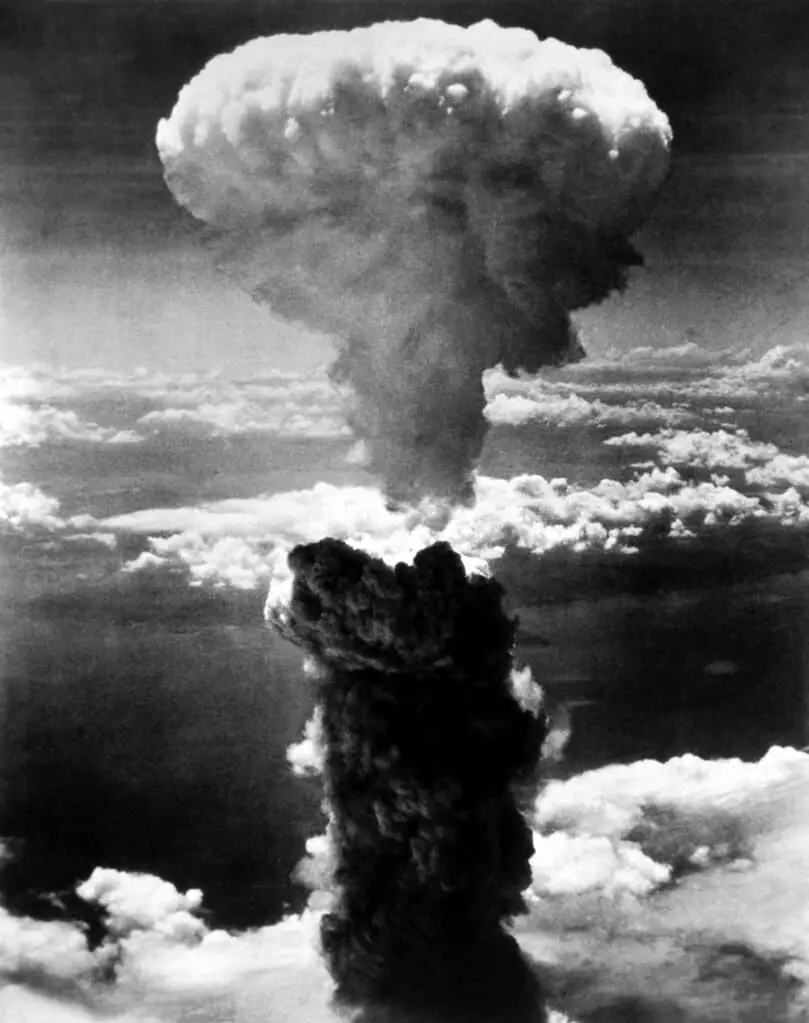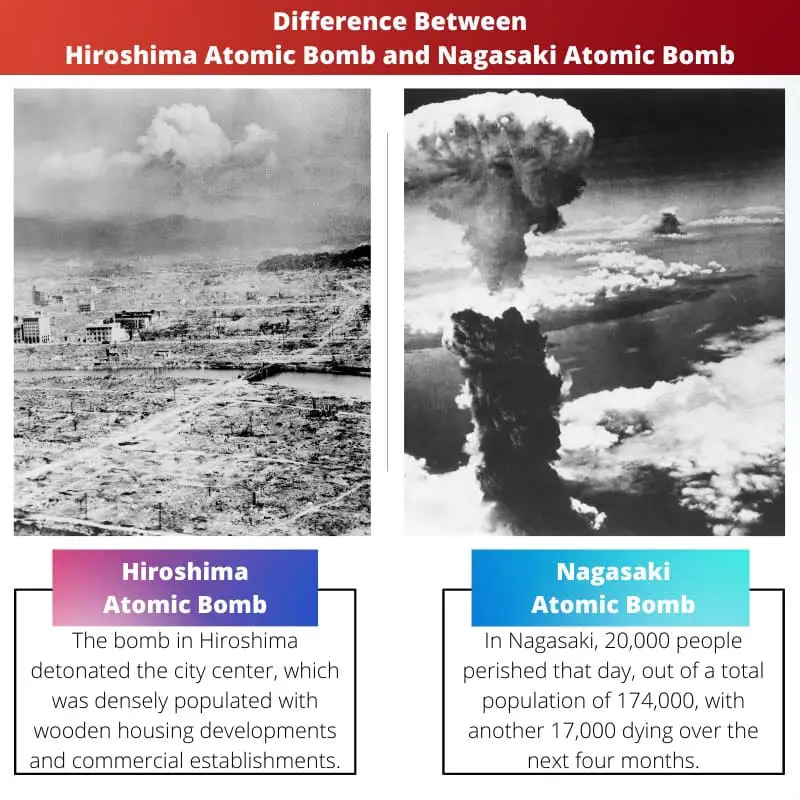The Hiroshima atomic bomb, “Little Boy,” used uranium-235 and was dropped on August 6, 1945. The Nagasaki bomb, “Fat Man,” used plutonium-239 and was detonated on August 9, 1945, marking the devastating culmination of World War II’s Manhattan Project.
Key Takeaways
- The atomic bomb dropped on Hiroshima was a uranium-based bomb named “Little Boy,” while the one on Nagasaki was a plutonium-based bomb called “Fat Man.”
- The Hiroshima bomb resulted in approximately 135,000 casualties, while the Nagasaki bomb caused around 64,000 deaths.
- The bombings of Hiroshima and Nagasaki led to Japan’s surrender in World War II. They contributed to the development of international laws and treaties to prevent the use of nuclear weapons.
Hiroshima Atomic Bomb vs Nagasaki Atomic Bomb
Hiroshima Atomic Bomb nicknamed “Little Boy,” was a gun-type bomb that used uranium-235 as its fissile material, was 13 feet long, and weighed 4.5 tons. Nagasaki Atomic Bomb, nicknamed “Fat Man,” was an implosion-type bomb that used plutonium-239 as its fissile material at 10 feet long.

The bomb in Hiroshima detonated in the city center, which was densely populated with wooden housing developments and commercial establishments.
Because of these reasons, the mortality and damage in Hiroshima were exceptionally great. Hiroshima’s firestorm damaged 13 square kilometers (five square miles) of the entire city.
Almost 63 percent of Hiroshima’s structures were utterly destroyed, and more were heavily damaged.
In Nagasaki, 20,000 people perished that day, out of a total population of 174,000, with another 17,000 dying over the next four months.
And the warhead that destroyed the city was named ‘Fat Man,’ and it was a plutonium-based atomic bomb with a much more complex structure compared to the former.
Comparison Table
| Feature | Hiroshima | Nagasaki |
|---|---|---|
| Date of bombing | August 6, 1945 | August 9, 1945 |
| Type of bomb | Uranium-gun type (“Little Boy”) | Plutonium implosion type (“Fat Man”) |
| Yield | Approximately 15 kilotons of TNT | Approximately 21 kilotons of TNT |
| Detonation altitude | Approximately 600 meters (1,968 feet) | Approximately 500 meters (1,640 feet) |
| Estimated immediate deaths | 70,000 – 130,000 | 39,000 – 86,000 |
| Total estimated deaths (including radiation-related deaths) | 90,000 – 240,000 | 60,000 – 88,000 |
| City size and topography | Flat river delta, population around 350,000 | Mountainous terrain, population around 250,000 |
| Building materials | Mainly wooden structures | More varied, including some fire-resistant concrete structures |
| Impact of blast and fire | Widespread destruction over a large area, intense firestorm | Concentrated damage in the valley, less extensive firestorm due to terrain |
| Impact of radiation | Significant, with long-term health effects on survivors | Similar to Hiroshima, but affected area smaller due to terrain |
What is Hiroshima Atomic Bomb?
Background and Development
The Hiroshima atomic bomb, codenamed “Little Boy,” was developed as part of the Manhattan Project during World War II. The project aimed to create a powerful nuclear weapon to ensure the Allies’ strategic advantage.
Technical Details
“Little Boy” utilized uranium-235 as its fissile material. The bomb relied on a gun-type design, where two sub-critical masses of uranium-235 were brought together to form a critical mass, initiating a self-sustained nuclear chain reaction.
Deployment and Impact
On August 6, 1945, the United States dropped the Hiroshima bomb from the Enola Gay, a B-29 bomber. The explosion occurred at an altitude of approximately 600 meters above the city, resulting in a devastating blast, intense heat, and lethal radiation. The immediate and long-term effects caused unprecedented destruction, with estimates of tens of thousands killed instantly and many more succumbing to injuries and radiation-related illnesses in the following years.
Historical Significance
The bombing of Hiroshima marked the first wartime use of a nuclear weapon and had profound implications on global geopolitics, leading to Japan’s surrender and the end of World War II. The event also initiated discussions and debates about the ethical and moral considerations of nuclear warfare.

What is Nagasaki Atomic Bomb?
The Nagasaki atomic bomb, codenamed “Fat Man,” was part of the United States’ Manhattan Project during World War II. Following the success of the Hiroshima bombing, the decision to deploy another nuclear weapon was made as a strategic move to expedite Japan’s surrender.
Design and Composition
“Fat Man” was an implosion-type nuclear weapon, utilizing a spherical design. Its core consisted of plutonium-239, a fissile material, surrounded by a tamper to increase compression during detonation. The bomb also included a beryllium initiator to initiate the chain reaction.
Detonation and Impact
On August 9, 1945, the B-29 bomber “Bockscar” dropped the Nagasaki bomb over the city. The explosion, with an estimated yield of 21 kilotons, resulted in widespread destruction, causing immediate deaths, injuries, and long-term health issues due to radiation exposure. The devastating impact played a significant role in Japan’s decision to surrender, leading to the end of World War II.

Main Differences Between Hiroshima Atomic Bomb and Nagasaki Atomic Bomb
- Design and Composition:
- Hiroshima: “Little Boy” used uranium-235, employing a gun-type design.
- Nagasaki: “Fat Man” utilized plutonium-239 and featured an implosion-type design.
- Bomb Yield:
- Hiroshima: “Little Boy” had an estimated yield of around 15 kilotons.
- Nagasaki: “Fat Man” had a higher estimated yield of about 21 kilotons.
- Impact and Targets:
- Hiroshima: Targeted on August 6, 1945, resulting in significant casualties and destruction.
- Nagasaki: Targeted on August 9, 1945, with widespread destruction and a crucial role in Japan’s surrender.
- Role in Ending WWII:
- Hiroshima: Marked the first use of a nuclear weapon, contributing to Japan’s surrender.
- Nagasaki: Reinforced the message of devastating power, hastening Japan’s decision to end World War II.
- Fissile Material:
- Hiroshima: Used uranium-235 as the fissile material.
- Nagasaki: Used plutonium-239 as the fissile material.
- Bomb Delivery:
- Hiroshima: Dropped by the Enola Gay on August 6, 1945.
- Nagasaki: Dropped by the B-29 bomber “Bockscar” on August 9, 1945.

The catastrophic effects of the atomic bombings underscore the ethical concerns and complexities associated with military and scientific advancements. These remain pertinent considerations for global security and peace-building efforts.
Certainly, the lasting impact of these events serves as a sobering reminder to navigate the intersecting realms of science, ethics, and international relations with utmost care and conscientiousness.
In a world plagued by nuclear tensions, the sobering historical accounts of Hiroshima and Nagasaki’s destruction serve as a clarion call for robust disarmament measures and diplomatic initiatives to prevent future nuclear catastrophes.
The devastating impact of the atomic bombs on Hiroshima and Nagasaki marked a significant turning point in our history. This affirms how vital it is to ensure the responsible use of nuclear power.
Indeed, the events of Hiroshima and Nagasaki necessitated discussions on the ethical and humanitarian implications of nuclear warfare, guiding international policies and treaties.
The detailed accounts comparing the bombs’ technical and historical aspects offer a comprehensive understanding of their profound influence on the world. It’s crucial to acknowledge these aspects for informed reflections on history.
Agreed! This comprehensive analysis prompts contemplation and fosters informed discussions on the historical, ethical, and global repercussions of nuclear weapons and warfare.
The destruction caused by the Little Boy and Fat Man bombs highlights the moral responsibility that comes with technological advancements. The whole world must heed these lessons to prevent such tragedies from recurring.
Absolutely, the impact of these weapons remains a somber reminder of the need for peace and global cooperation to ensure the world’s safety and security.
Isn’t it ironic how mankind’s most destructive creations could also serve as catalysts for global peace initiatives and the pursuit of nuclear non-proliferation? The world’s history is indeed a complex and thought-provoking narrative.